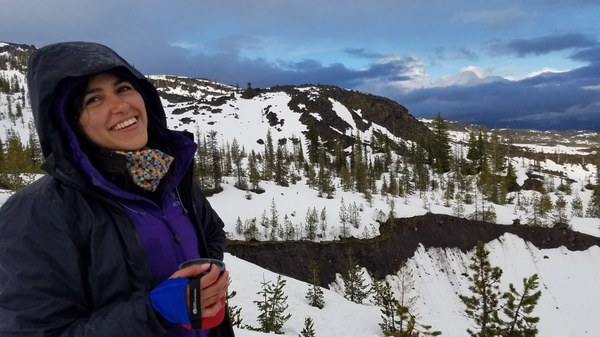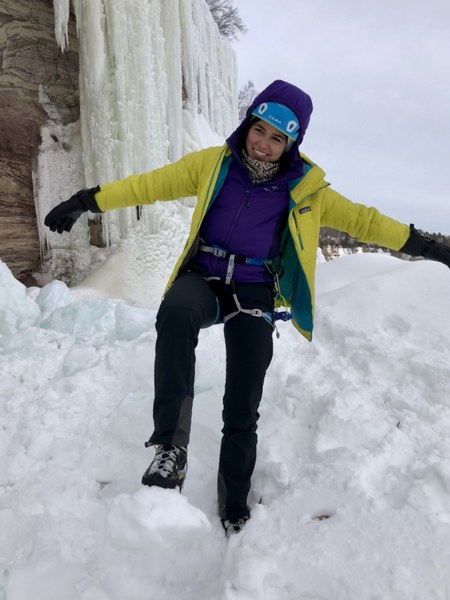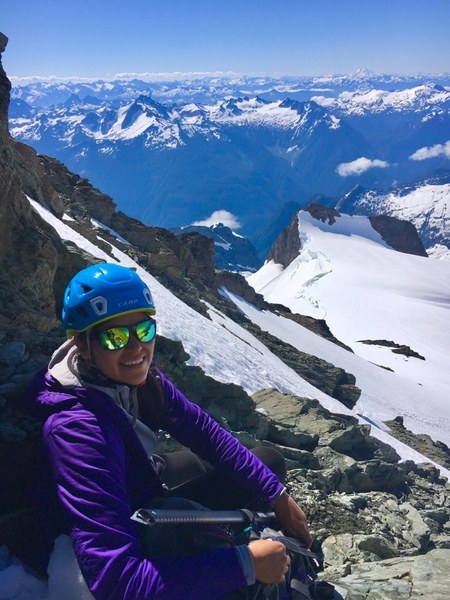
Birthdays are an annual reminder of the passing of time. From the first time you hit double-digits to becoming an official teenager to getting your driver's license to being able to vote and then drink, many of us have rituals to mark these significant milestones. One popular tradition is the idea of a #30Before30 challenge, and today a new cohort of late 20-somethings is taking this challenge to the next level.
One such example is the new self-created challenge by Liz Sahagun. Inspired by the #30Before30 Challenge of Theresa Silverya, which we highlighted in our Fall 2020 edition of Mountaineer magazine, Liz is taking 3-months to travel and climb 30 ice routes with other people of underrepresented backgrounds to raise awareness while fundraising for Climbers of Color mountaineering courses, SheJumps BIPOC (Black, Indigenous, People of Color) programming, and independent scholarships for up and coming leaders. Her goal is to be the role model she wishes she grew up with, and to provide funds for other people of color to advance their skills in climbing and mountaineering.
 To understand the difference this challenge will make, I sat down with Liz to learn more about her, the #30Before30 challenge she created, and what inspired her to step up as a role model for others.
To understand the difference this challenge will make, I sat down with Liz to learn more about her, the #30Before30 challenge she created, and what inspired her to step up as a role model for others.
Tell me about yourself. When did you become interested in the outdoors?
I’m from a small town in rural California. My parents were farm laborers when they came to the States, and that's the community that I grew up in. I went to undergrad at UC Davis, which was still pretty close to home. I moved out but it was still great to be around California diversity. Now I’m in the midwest. I moved here for school in 2016.
My spark for the mountains started when I studied abroad in Chile in undergrad. I spent a semester there and had a lot of freedom to travel. I loved being so close to the Andes. I decided to go to Patagonia where I spent time in Torres del Paine and Fitz Roy range. Walking around the mountains and just seeing how big and graceful they are was really inspiring.
A few years after I got back, I decided to spend a month in Nepal in the Himalayas to go to Everest Base Camp by myself. That trip really pushed me to learn more about the mountains and see what I’m capable of navigating. How do you even know where to go when everything is new and intimidating? I was going off a guidebook, some maps, and some blog posts from people that had done that trip. I mainly wanted to see if I could do it, and I did.
When I got back, I bought a car and I did a big road trip through national parks. I wanted to see how many national parks I could go to in a year, which was the year before I moved to Indiana for grad school. I was like, ‘If I'm going to leave the West coast, I'm going to see the West coast.’ I made it to 16 parks, from Death Valley to the Grand Canyon and up to Rainier and the Olympics.
How did you first get into ice climbing?
When I moved to Indiana for grad school, I was trying to find things to do in the winter that would advance my mountaineering skills so I can go higher into the mountains. I decided to learn how to ice climb. I eventually want to develop more skills to get into alpine style climbing. Ice climbing seemed like the most accessible thing and the most natural progression toward that goal.
I was looking at ice festival clinics and a lot of them were pretty expensive, which was discouraging given the cost of my own gear. I eventually found an intro clinic in Minnesota that was really affordable. I convinced a friend to come with me to this small ice fest in the middle of Minnesota, and we learned how to ice climb there. The community was really nice, and I kept going back to climb with them. So most of my climbing has been out in the Midwest, and I’m excited to expand to more areas as part of my challenge too. I plan to climb in Montana, Utah, Colorado, then back to Minnesota, and Michigan.
What’s your favorite thing about ice climbing?
People see ice climbing as a big adrenaline rush where you’re just bashing away. But I think ice climbing is really peaceful. Once you get into the zone, it’s so rhythmic and your self awareness increases so much. It’s different from rock climbing where you’re focused on a specific hold and a specific move that is going to stay constant every time you do it. Ice climbing is a more dynamic medium. I like that you make your own way and really become present with every move.
Ice itself is amazing too. It varies so much from the start to the end of the season, and even within the same day based on temperature. It’s different when it’s really, really cold than when it's a more comfortable temperature. It looks, feels, and sounds different, which tells you a lot about the environment around you. Ice climbing seems so intimidating, but I think it's meditative to be there and figure it out.

You’re making your own way in a lot of areas. As a woman of color trying to break into the ice climbing world and a PhD candidate in the neuroscience program at Purdue, can you speak to the importance of mentorship and how you think your presence in these places is making a difference?
The lack of representation is really tough. We've seen white men on mountain tops in magazines and on TV for decades - that is the narrative of mountaineering. It makes it hard to stay inspired for someone like me who doesn’t fit that narrative. The lack of representation is really tough. And, we operate in a system where the older generation mentors the younger generation, which means we have a long history of men training other men, particularly white men. We need more mentorship programs and better representation in media and on professional athlete rosters. We need role models.
That’s why I’ve been working with Climbers of Color. Their model is increasing leadership and mentorship in mountaineering. I think their work is really cool, and I reached out to connect and talk about expanding the ice program. I want to learn enough to be a mentor to other climbers of color and eventually, hopefully, a professional instructor. Thanks to their programs, I have more opportunities to make that happen, and, as a Director of Ice Programs for Climbers of Color, I have a pathway to do it.
I have been doing a lot of work at Purdue around mentorship too. I think being in an academic space helps me see what I can do in mountaineering to make it more equitable and inclusive. A lot of it is meeting mentees where they are and offering them the support they need to move upward. That’s what my mentors do, and what I try to do with mentees. Having supportive peers and role models that see you and genuinely believe in you is really what makes us come through and be successful. I know what good mentorship looks like, and that’s part of why I'm trying to step into leadership roles in academia and in the outdoors.
It sounds like a lot of different experiences inspired your #30Before30 Challenge. How did you come up with it?
This project was inspired by Theresa Silveyra’s #30Before30. She posted something on social media about wanting to climb with more women of color, so I messaged her and we met up when I was on the west coast. We climbed Mount Shuksan together and that was really powerful. I really wanted to create more experiences like the one we had on the mountain that day, so we brainstormed about how I could do that.
Theresa and I talked through a lot of the challenges we’ve faced and what we might be able to do to create safer spaces for our own community to get into these sports. We both struggled with safe partnerships. A lot of ice climbers reach out to people through social media climbing groups, but as a woman and as a person of color, that is a really big risk. We also realized that having someone say “I want to climb with people like you” can be so so powerful. That’s what she did, and we connected, so that’s what I’m doing for this project. Equity is meeting people where they are and that’s what I’m doing, literally and metaphorically.

What’s the project, and what are your goals?
My goal is to climb 30 pitches with people from underrepresented backgrounds. I've been really excited to connect with people like me - people who share the same intimidation as I did when I first started and people trying to change mountain narratives. A lot of ice clinics are really a big commitment and the environment caters to able-bodied, cis white males of higher socioeconomic status. It's tough to be a beginner in that environment, and I want to help change that dynamic and use my presence to inspire others like me to give it a try. A lot of people have reached out and I’ve been making progress quickly. I’m in Montana now, and will be driving to Utah, Colorado, Minnesota, and Michigan in a big loop. I am lucky enough to teach remotely next semester, while I travel, so I’m excited to see where this takes me.
I’m a week into the challenge and have knocked off 10 climbs in Bozeman, Montana. I’m really not a great ice climber yet, so I’ve been focusing on my own skills first and learning to lead on ice. Once I get a little more skilled and comfortable, I’ll focus on climbing with newer climbers and really bringing people into the sport. I think once I get to 30 climbs, I’ll level up to 30 people by the end of the season, depending on how COVID unfolds. If I meet that goal, I’ll find another 30 challenge to keep leveling up before March 28 (my birthday).
Why did you decide to make it a fundraiser?
Because of how successful Theresa’s challenge was, I want to make mine a fundraiser too. People of color face so many barriers: lack of mentorship, lack of clarity around skill development, and the expense of those courses. I wanted my project to chip away at all of those barriers. The fundraiser will be for marginalized people of color who want to step into leadership roles and take up more space in the community. I see it as a sign of whether people think we’re worth investing in. By the amount of donations coming in, it looks like the answer is yes and that’s really affirming.
How can people support your challenge and follow your journey?
I've set up an online fundraiser where people who have the means can donate. It also has links to my social media accounts where I’m sharing how it’s been going so far. People can also Venmo me directly for gas or treat me and my partners to drinks or dinners.
It has been really fun to share bits of behind the scenes on my Instagram page . The journey isn’t just about the cool and diverse climbing photos, it’s about the community that supports me becoming the role model I wish I had. It’s about the pure joy of ice climbing and working hard, and the emotional challenges of me trying to be visible in a space where I’ve felt invisible for so long. I’m in a really vulnerable position so donations, likes, shares, comments, follows, messages, etc. really help me keep going. There is so much love and support and excitement on my page. I believe it makes a difference by giving others hope that the broader mountaineering community is ready for new narratives. Everyone should have access to meaningfully experience the outdoors.
 Kristina Ciari Tursi
Kristina Ciari Tursi